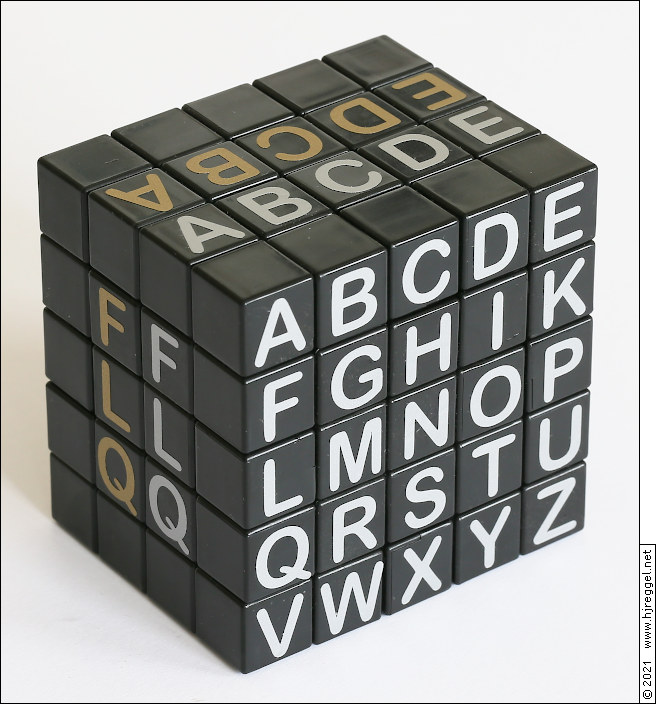 | |
| Black 5×5×4 "Domino Style" Silver/Gold Alphabet Cuboid | |
funCUBING Index Page · funCUBING Projects · The Domino Project
There are different challenges, when trying to apply the Domino Principle to certain twisty puzzles. One challenge is the availability of body colors. Another challenge is the count of cubie faces on the main faces. With a dot count above 16, it is very hard to read the value. Besides that, small dot sizes can't be implemented as individual dot stickers. This would require printed labels, or an inverted design with dots cut out from a solid sticker. However, an inverted sticker design reduces the available size even more, because of the margin required inside the sticker outline.
This is a collection of alternative ways how to implement the Domino Principle.
 | |
| Black 5×5×4 "Domino Style" Silver/Gold Alphabet Cuboid | |
The base for this design is an Ayi 5×5×4 Cuboid. Unlike the Calvin's Cuboids, the Ayi models have less rounded edges, giving a larger usable flat area on the cubie faces. Another advantage is the overall symmetry of the cubie faces. This means that inner and outer cubies have the same geometry.
Here we have a 15.1mm grid, and about 1mm edge radius. This leaves a flat area of 13x13mm. Using dots, the individual dots would be at most 2.5mm in diameter, with an inverted sticker design about 2.3mm maximum diameter.
For a 5×5 leading face, we need a sequence length of 25. The Latin Alphabet with 26 letters is the deal candidate for this. By leaving out the "J" (similar to the short-I in the Cyrillic Alphabet), there are 25 letters from A to Z.
It looks like there is only a black bodied version of the cuboid available. Therefore, different colors were chosen for the letters. The colors Silver and Gold have already been used on black and white bodied Mirror Cubes. The colors show reasonable contrast on both body colors, especially on black.
To sum up the rules of the "Domino Principle": The sequence of 25 letters replaces the Domino Dots. The letters have the advantage of a more determined orientation. The colors of the letters replace the body colors. The cuboid has a plain black body, the leading half has silver letters, the opposite half has golden letters.
There are 16 letters on each inner layer, the nine inner face cubies are not visible. The number of marked cubie faces on a "Domino" or "Domino Style" twisty puzzle is always equal to the number of visible cubies. Each of the visible cubies is marked once, the resulting cuboid is fully determined including placement of the inner face cubies. If the cuboid has centers, the orientation of the centers does not have to be determined. But having a determined center orientation is a bonus.
In the given case, the letter "N" ended up on the center. Depending on the individual font, the orientation of the letters can be partially or fully determined. Letters HSXZ usually have a slightly asymmetrical shape, while letters NIO can be identical in regular orientation and at 180° rotation.
funCUBING Index Page · funCUBING Projects · The Domino Project · Top of Page